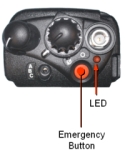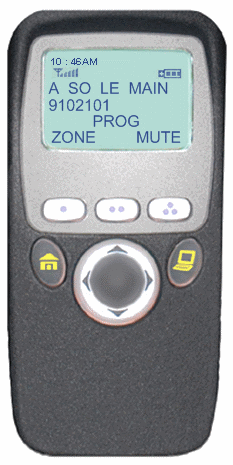All public safety radios on BRICS have the emergency alarm and emergency call features.
Definitions
An Emergency Alarm occurs when the emergency button on a subscriber radio (portable or mobile) is pressed. The alarm is transmitted with data on the system’s control channel and is forwarded to the dispatchers’ radio consoles. The console provides an audible and visual indication of the alarm for the dispatcher.
The Emergency Call mode begins automatically after sending an emergency alarm. All emergency calls transmitted after the alarm have the highest priority in the system.
![]()

Frequently Asked Questions
The Emergency Alarm Button
The Emergency Revert Talkgroup
Sending an Emergency Alarm
Resetting Your Radio
![]()
Frequently Asked Questions
Can I send an emergency alarm while the system is busy or while someone is talking on my selected talkgroup?
Yes. The emergency alarm is transmitted through the control channel as data, so it will be sent and processed even if your selected talkgroup has voice traffic, or if all of the system’s voice channels were in use at the time.
Will the dispatchers in my dispatch center receive the emergency button?
Yes. The dispatcher’s console will receive the alarm no matter what talkgroup they are currently using. The volume on the talkgroup with the emergency will automatically be turned up to maximum.
Visit the emergency alarm guide for dispatchers to see what the alarm looks like on a console in your dispatch center.
Once I press my emergency button, will I be “talked over” by field units or dispatchers when I call for help?
Once the alarm has been sent, any subsequent transmissions are emergency calls with the highest priority on the radio system. In this situation, you will have a higher priority than other field units and dispatchers.
When an emergency call request is made during a period of time when all voice channels are busy, the request takes a priority over any other type of call request.
Our system is programmed for emergency calls to use “ruthless preemption.” When an emergency call request is made during a period of time when all voice channels are busy, the request takes a priority over any other type of call request. Rather than going to the top of the busy queue, our emergency calls use ruthless preemption. This mode of operation causes the controller to look at the priority of the talkgroups assigned to the voice channels and preempt the talkgroup with the lowest priority so the channel can be assigned to the emergency caller.
Does pressing my emergency button cause an open mic?
For most users, the answer is no. There is a “hot mic” option on our radios, but it is not enabled. The emergency button simply sends the alarm. Your PTT button will then initiate any emergency call.
The emergency hot mic feature is used by the Butler County Jail and on School Emergency Radios.
If I press my emergency button on an incident talkgroup, will I stay on that channel?
There are two types of emergency alarm behaviors – tactical, and revert. Tactical alarms keep you on the same talkgroup and deliver the alarm to a dispatcher on the selected talkgroup. Revert alarms change your radio to a designated talkgroup, and deliver the alarm to a dispatcher on the revert talkgroup.
On 09 FIRE, 09 TAC and 09 MA talkgroups, alarms are tactical and the user will stay on the incident talkgroup. 0n 09 LAW talkgroups, users revert to their A-1 dispatch talkgroup.
See more information on Emergency Revert below.
Why does the speaker microphone on fire radios have an emergency button?
The Commander remote speaker microphone used on all Butler County fire radios allows the use of the emergency alarm button, as well as volume control and PTT. It is provided so that firefighters may activate the alarm with a gloved hand, even if the radio is obstructed by personal protective equipment (PPE).
During a fatal fire at the Indianapolis Athletic Club in 1992, an IFD Fire Captain was seriously injured when he was forced to remove protective clothing to activate the emergency alarm on his radio. A report issued following the incident recommended manufacturers provide firefighters a way to send emergency alarms without compromising PPE. The Commander microphone was designed for this purpose. Click here to learn more about the speaker microphone.
The Emergency Alarm Button
The emergency alarm is activated with a large orange button, shown below.


The Emergency Revert Talkgroup
There are two types of emergency alarm behaviors – tactical, and revert. Tactical alarms keep you on the same talkgroup and deliver the alarm to a dispatcher on the selected talkgroup. Revert alarms change your radio to a designated talkgroup, and deliver the alarm to a dispatcher on the revert talkgroup.
When the emergency alarm button is pressed, depending on your talkgroup selection, the radio may be set up with an “emergency revert” talkgroup. In these instances, radio reverts or switches to this talkgroup automatically to send the alarm.
On Butler County talkgroups:
On 09 FIRE, 09 TAC and 09 MA talkgroups, alarms are tactical and the user will stay on the incident talkgroup.
0n 09 LAW talkgroups, and any other Butler County public safety talkgroup, users will revert to their main dispatch talkgroup (Zone A, Channel 1). The user will leave their selected talkgroup to send the alarm on A-1. The radio will not return to the selected talkgroup until it is reset.
On a talkgroup for any other system (Hamilton County, etc):
Your radio will alarm to a comm center on the other system. See the page on Other Systems for the particular system emergency info.
On a conventional channel (e.g. 8 CALL 90, 7 FIRE 63D):
You can not send an emergency alarm to dispatchers on conventional or simplex channels. An alarm will make a “best effort” to give an audible alert to other radios on the same channel in the same vicinity as the alarming radio. Other users will hear an audible alert indicating that someone has an emergency, but identification information will not be broadcast to a dispatcher.
Sending an Emergency Alarm

With the radio powered on and a talkgroup selected, press the emergency button.
If successful, you will hear a group of short, medium-pitched tones. On the display, the current talkgroup name will alternate with “EMERGENCY”.
![]() Click to listen to the tones you’ll hear
Click to listen to the tones you’ll hear
At this point, your radio will have sent an alarm to the dispatch center. Consoles will sound an audible alarm and the talkgroup will flash red, and the alias of the radio alarming will appear in red with a notation indicating the alarm.
Press the PTT button and announce your emergency. All transmissions from your radio will be sent as emergency calls with the highest priority on the system, until the radio has been reset.
Note: If you were operating on a talkgroup that uses revert emergency, the radio will have switched to the revert talkgroup before sending the alarm. There will be no indication of this on the screen, however. The radio will still display the name of your selected talkgroup but you will actually be transmitting and receiving on the revert talkgroup (most likely Zone A, Channel 1) during your emergency. You will not return to your previously selected talkgroup until after resetting the radio. The dispatcher can not reset your radio for you.
Resetting the Radio
Press and hold the emergency button until a solid tone is heard.
Alternative: Turn the radio off and back on.
Verify that your radio is no longer flashing “EMERGENCY”. If so, it has been reset. Your radio will return to your previously selected talkgroup, as displayed on the screen.